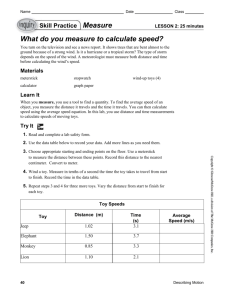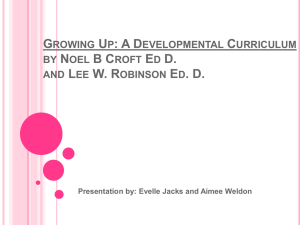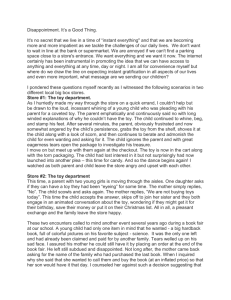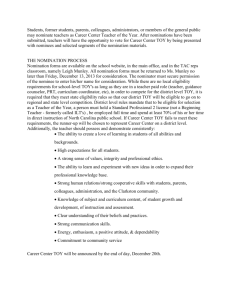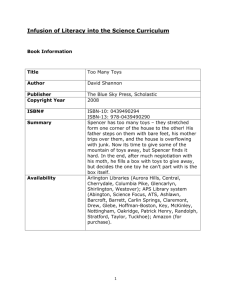Grades K-2 Design and Build a Toy
advertisement
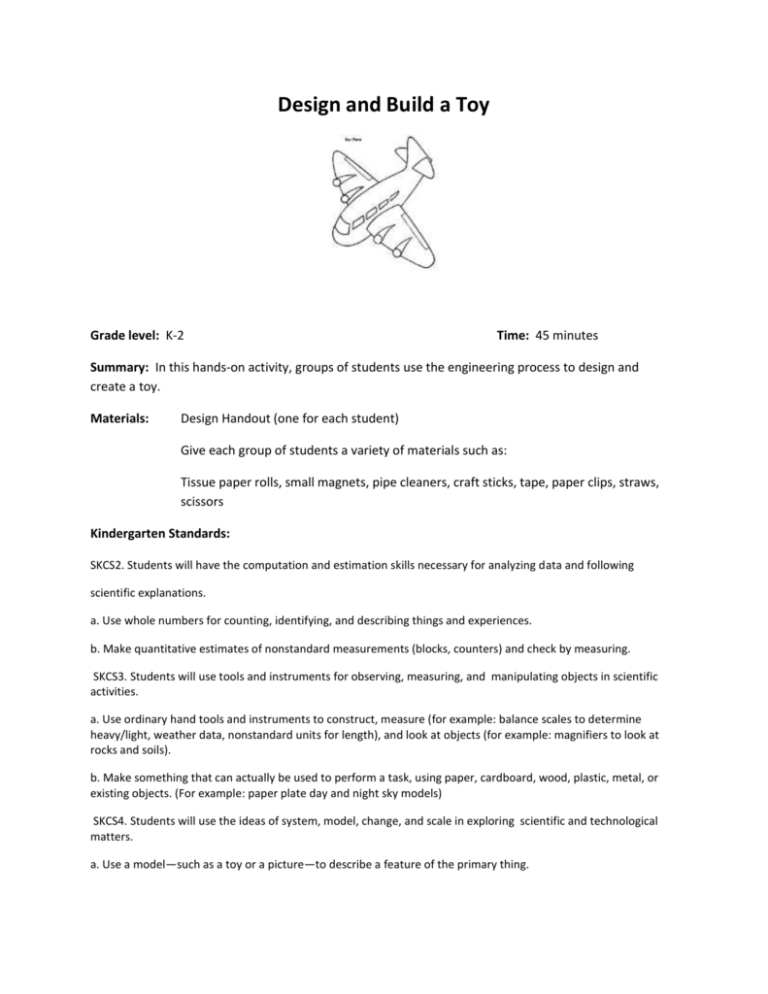
Design and Build a Toy Grade level: K-2 Time: 45 minutes Summary: In this hands-on activity, groups of students use the engineering process to design and create a toy. Materials: Design Handout (one for each student) Give each group of students a variety of materials such as: Tissue paper rolls, small magnets, pipe cleaners, craft sticks, tape, paper clips, straws, scissors Kindergarten Standards: SKCS2. Students will have the computation and estimation skills necessary for analyzing data and following scientific explanations. a. Use whole numbers for counting, identifying, and describing things and experiences. b. Make quantitative estimates of nonstandard measurements (blocks, counters) and check by measuring. SKCS3. Students will use tools and instruments for observing, measuring, and manipulating objects in scientific activities. a. Use ordinary hand tools and instruments to construct, measure (for example: balance scales to determine heavy/light, weather data, nonstandard units for length), and look at objects (for example: magnifiers to look at rocks and soils). b. Make something that can actually be used to perform a task, using paper, cardboard, wood, plastic, metal, or existing objects. (For example: paper plate day and night sky models) SKCS4. Students will use the ideas of system, model, change, and scale in exploring scientific and technological matters. a. Use a model—such as a toy or a picture—to describe a feature of the primary thing. b. Describe changes in size, weight, color, or movement, and note which of their other qualities remains the same. (For example, playing “Follow the Leader” and noting the changes.) c. Compare very different sizes (large/small), ages (parent/baby), speeds (fast/slow), and weights (heavy/light) of both manmade and natural things. SKCS5. Students will communicate scientific ideas and activities clearly. a. Describe and compare things in terms of number, shape, texture, size, weight, color, and motion. b. Begin to draw pictures that portray features of the thing being described. SKP1. Students will describe objects in terms of the materials they are made of and their physical properties. a. Compare and sort materials of different composition (common materials include clay, cloth, paper, plastic, etc.). b. Use senses to classify common materials, such as buttons or swatches of cloth, according to their physical attributes (color, size, shape, weight, texture, buoyancy, flexibility). 1st Grade Standards S1CS2. Students will have the computation and estimation skills necessary for analyzing data and following scientific explanations. a. Use whole numbers in ordering, counting, identifying, measuring, and describing things and experiences. b. Readily give the sums and differences of single-digit numbers in ordinary, practical contexts and judge the reasonableness of the answer. c. Give rough estimates of numerical answers to problems before doing them formally. d. Make quantitative estimates of familiar lengths, weights, and time intervals, and check them by measuring. S1CS3. Students will use tools and instruments for observing, measuring, and manipulating objects in scientific activities. a. Use ordinary hand tools and instruments to construct, measure, and look at objects. b. Make something that can actually be used to perform a task, using paper, cardboard, wood, plastic, metal, or existing objects. c. Identify and practice accepted safety procedures in manipulating science materials and equipment. S1CS4. Students will use the ideas of system, model, change, and scale in exploring scientific and technological matters. a. Use a model—such as a toy or a picture—to describe a feature of the primary thing. b. Describe changes in the size, weight, color, or movement of things, and note which of their other qualities remain the same during a specific change. c. Compare very different sizes, weights, ages (baby/adult), and speeds (fast/slow) of both human made and natural things. S1CS5. Students will communicate scientific ideas and activities clearly. a. Describe and compare things in terms of number, shape, texture, size, weight, color, and motion. b. Draw pictures (grade level appropriate) that correctly portray features of the thing being described. c. Use simple pictographs and bar graphs to communicate data. S1P2. Students will demonstrate effects of magnets on other magnets and other objects. a. Demonstrate how magnets attract and repel. b. Identify common objects that are attracted to a magnet. c. Identify objects and materials (air, water, wood, paper, your hand, etc.) that do not block magnetic force 2nd Grade Standards S2CS2. Students will have the computation and estimation skills necessary for analyzing data and following scientific explanations. a. Use whole numbers in ordering, counting, identifying, measuring, and describing things and experiences. b. Readily give the sums and differences of single-digit numbers in ordinary, practical contexts and judge the reasonableness of the answer. c. Give rough estimates of numerical answers to problems before doing them formally. d. Make quantitative estimates of familiar lengths, weights, and time intervals, and check them by measuring. S2CS3. Students will use tools and instruments for observing, measuring, and manipulating objects in scientific activities. a. Use ordinary hand tools and instruments to construct, measure, and look at objects. b. Assemble, describe, take apart, and reassemble constructions using interlocking blocks, erector sets and other things. c. Make something that can actually be used to perform a task, using paper, cardboard, wood, plastic, metal, or existing objects. S2CS4. Students will use the ideas of system, model, change, and scale in exploring scientific and technological matters. a. Identify the parts of things, such as toys or tools, and identify what things can do when put together that they could not do otherwise. b. Use a model—such as a toy or a picture—to describe a feature of the primary thing. c. Describe changes in the size, weight, color, or movement of things, and note which of their other qualities remain the same during a specific change. d. Compare very different sizes, weights, ages (baby/adult), and speeds (fast/slow) of both human made and natural things. S2CS5. Students will communicate scientific ideas and activities clearly. a. Describe and compare things in terms of number, shape, texture, size, weight, color, and motion. b. Draw pictures (grade level appropriate) that correctly portray features of the thing being described. c. Use simple pictographs and bar graphs to communicate data. S2P2. Students will identify sources of energy and how the energy is used. a. Identify sources of light energy, heat energy, and energy of motion. b. Describe how light, heat, and motion energy are used. S2P3. Students will demonstrate changes in speed and direction using pushes and pulls. a. Demonstrate how pushing and pulling an object affects the motion of the object. Teacher Notes: Bring a few toys to class to share with students. Point out that some toys have moving parts and others do not. If you have an extra day for this activity, let students take apart some of the toys with moveable parts to see how they work. As a class, decide on a way to classify the toys into groups. For example, you might sort them as toys that do not move, toys that are battery operated, and toys that have moveable parts but no batteries. Or the toys could be classified by color, size, or composition (such as plastic, wood, fabric). In grade 2, discuss the sources of energy used in some toys such as batteries and wind-up mechanisms. Extend the activity to include questions about the use of energy in toys and how that energy results in forces that cause the toy to move. When students are brainstorming their designs for a toy, tell them the limits or constraints that will guide their work. These constraints are: Only the materials provided by the teacher can be used. (Point out that students do not have to use all of the materials.) Time is limited. The teacher will determine how much time students can spend on this activity. Procedure: 1. Divide students into groups of 3 or 4. Present the challenge to students: A new student, Mattie, has joined your class. Her family was forced to leave their home because of a flood that damaged their house. Mattie and her family escaped safely, but they had to leave all of her toys behind. Can you use the materials provided to create a toy for Mattie? 2. Show students the materials that are available. Ask each student to silently think about some ideas for a new toy made from these materials. Give them 2 or 3 minutes. Let each student sketch his/her idea in the Box A on the Design Handout. 3. When sketching is complete, request that students share their ideas with the group. 4. Give the group time to discuss all of the ideas and decide which one they want to use to build a toy. Have each student sketch the final idea in Box B on the Design Handout. 5. Using the sketches in Box B of the Design Handout as a guide, let the group create their toy. 6. If the toy has moving parts, have students test it to see if it works correctly. Have students examine the finished toy to see if it needs any changes or improvements. 7. Allow students a few minutes to make any necessary changes or improvements to their toy. 8. Let each group of students share their toy with the class. 9. Display all toys on a table in front of the room. Ask students to compare the similarities and differences in the toys. 10. Probe students to reflect on the toy their group created. How could it be improved? 11. Have upper level students answer the questions on the Design Handout. Name ___________________________________ Design Handout Box A – Your idea for a toy. Box B – The group’s final idea for a toy. Optional Questions 1. Did your toy require a source of energy? If so, what supplied the energy? ______________________________________________ ______________________________________________ 2. How could a magnet be used in a toy? _____________________________________________ ______________________________________________

